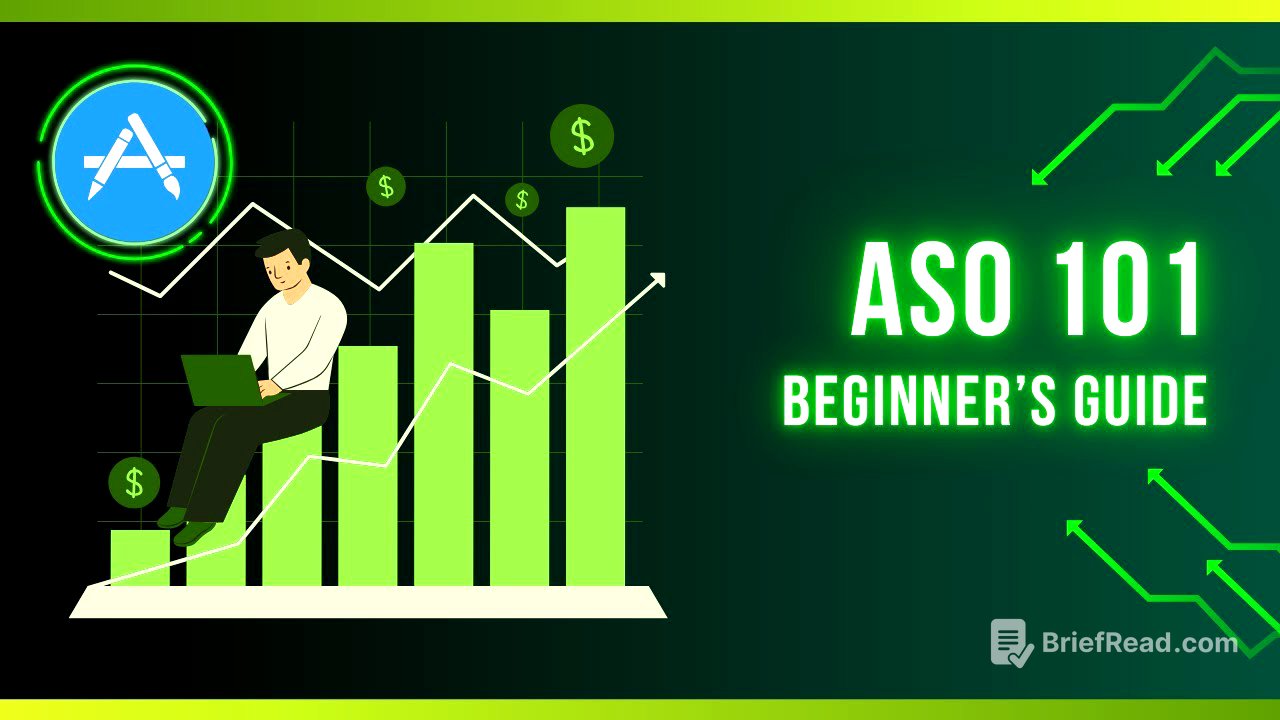TLDR;
This video provides an introduction to App Store Optimization (ASO), explaining its importance, key components, and how to approach it effectively. It emphasizes the necessity of ASO for increasing organic downloads, improving conversion rates, and reducing churn. The video covers keyword research, the inputs and outputs of ASO, and the challenges posed by the app store algorithms. It also suggests resources for further learning and highlights the iterative nature of ASO.
- ASO is crucial for app visibility and downloads.
- Keyword research is a fundamental part of ASO.
- ASO involves continuous iteration and adaptation.
Introduction [0:00]
The video introduces the topic of App Store Optimization (ASO) and sets the goal to provide viewers with a foundational understanding of the ASO process and basic techniques. It frames the video as a prerequisite for more advanced ASO topics, enabling viewers to understand content from other ASO-focused channels and blogs.
Conclusion [0:33]
The video emphasizes the importance of ASO, stating that it is essential for most apps to gain organic downloads. ASO can improve conversion rates and reduce churn. It acknowledges that ASO is complex and requires iteration, trial and error, and the use of tracking tools. It advises against aiming for perfection immediately and suggests approaching ASO as a long-term effort. The video also mentions that while ASO requires investment in tools, there are options available at different price points.
What is ASO [1:52]
App Store Optimization (ASO) is defined as a crucial tool for users to find, download, and potentially pay for an app. The video uses the example of searching for a sleep tracking app to illustrate how users typically find apps through the app store search function. It highlights that most users tend to download apps from the top search results, emphasizing the importance of ASO in achieving high rankings to increase the likelihood of downloads.
What are the inputs of ASO [4:12]
The direct inputs that can be controlled in ASO include the app name, subtitle, keywords, and screenshots. These elements are customizable each time an app is submitted to Apple. Indirect inputs that influence ASO but cannot be directly modified are the number of downloads, reviews, average ratings, and revenue. The video suggests influencing customer reviews and ratings through prompts, noting that resources are available to teach effective strategies for this.
What are the outputs of ASO [5:22]
The primary output of ASO is achieving a high ranking in the app store for targeted keywords. Ranking high for popular keywords can lead to a significant increase in daily downloads. ASO should also improve customer conversion rates, ensuring that users who download the app are genuinely interested in its features. The video uses personal app screenshots to illustrate poor ASO performance, noting low conversion rates and download numbers, and aims to improve these metrics through effective ASO strategies.
The opaque ASO algorithm [6:41]
The video addresses the challenge of improving app downloads by a significant percentage due to the complexity of Apple's app store algorithm. This algorithm is described as a "black box" that converts inputs into outputs, is situation-dependent, and nuanced. The video mentions that while there is no definitive handbook on Apple's algorithm, industry experts have studied and experimented extensively with it.
Keywords overview [7:47]
Keywords are the most important part of ASO, encompassing the title, subtitle, and keyword list. The title is more important than the subtitle, and the subtitle is more important than the keywords. The most impactful keywords should be in the title, followed by the subtitle, and then the keyword list. Duplicating keywords should be avoided because Apple's algorithm combines information from the title, subtitle, and keywords. Repeating keywords dilutes their impact, reducing the chances of ranking high for those terms.
Keywords example [10:13]
The video uses an example of a recording app focused on snore and sleep talk to illustrate common mistakes in keyword optimization. It points out issues such as keyword duplication and isolating words into individual units. The video explains that while "talks" is the plural of "talk," Apple automatically accounts for plurals, so it doesn't need to be added separately. It also notes that verb and noun forms of a word are not automatically merged, so both should be included if relevant.
Keyword research overview [12:59]
Keyword research is a process of identifying potential keywords, determining their effectiveness, testing them in the app's metadata, observing the results, and iterating. Many tools are available to assist with keyword research, most of which are paid or offer limited free access. These tools provide data such as popularity and difficulty scores for keywords. Popularity indicates the search traffic a keyword receives, while difficulty reflects how challenging it is to rank for that keyword.
Keyword research Demo [17:31]
The video demonstrates keyword research using Astro, a relatively inexpensive ASO tool. It shows how to check the popularity and difficulty scores of individual keywords. The video explains the concept of longtail keywords, which combine several words to target a more specific audience. It also demonstrates how to use Astro's suggestion feature to find related keywords and evaluate their suitability for the app.
Keyword research process summary [24:02]
The keyword research process involves brainstorming keywords, especially longtail keywords, and assessing their popularity and difficulty using tools like Astro. Keywords that meet the requirements are added to a list for potential use. These keywords are then incorporated into the app's title, description, and keyword list, with the most important keywords placed in the title. The video suggests using tools like ChatGPT to generate keywords and streamline the brainstorming process.
Expensive ASO tool explained [25:38]
More powerful ASO tools can significantly reduce the manual effort involved in keyword research by automating many steps. The video mentions tools like App Tweak, which uses AI to generate relevant keywords, and App Follow, which allows users to analyze competitors' keywords. ASO mobile is another tool that tracks the best-ranking keywords for an app, even those not included in the keyword list. The video advises spending money on ASO tools only if they generate a return on investment.
ASO summary [30:37]
The ASO process involves understanding the app's purpose and target audience, then brainstorming a list of keywords from various sources, including ChatGPT and competitor analysis. These keywords should include both single words and longtail phrases. It's important to save a working set of keywords as a backup in case new experiments negatively impact performance. Keywords should be ranked by their likelihood of ranking high and their relevance to the app, using tools to assess popularity and difficulty.
Learning resources [36:17]
The video recommends several resources for further learning about ASO. Steve from App Masters is highlighted for sharing free ASO advice on his YouTube channel, based on his experience optimizing numerous apps. Ariel from App Figures is also recommended for his expertise in using the App Figures tool and his content on keyword optimization and screenshots. Additionally, the video suggests searching for blog posts on specific ASO topics of interest.
Outro [38:26]
The video concludes by thanking viewers for watching and encouraging them to like and subscribe for more helpful content.









